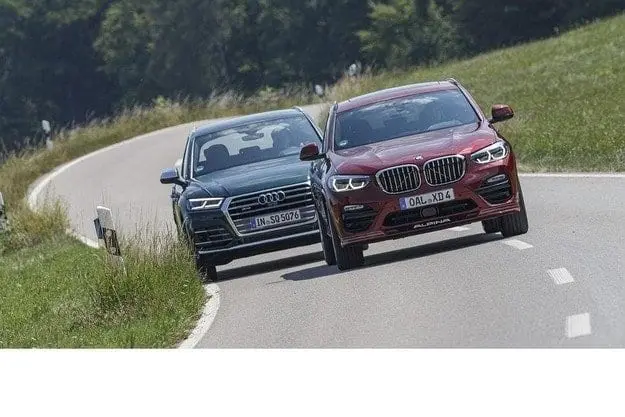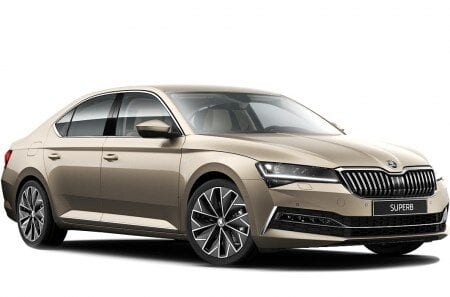
Test drive Audi SQ5, Alpina XD4: the magic of torque

Experience two expensive and powerful cars that promise a lot of fun on the road.
The two cars in the photo have 700 and 770 Newton meters. It's hard to find another powerful SUV model in this class with much more traction. The Alpina XD4 and Audi SQ5 give us huge amounts of torque born of spontaneous combustion and many other useful things..
Landscapes in our photographs are often blurry and appear to be passing cars. This is because our photographers express the perception of speed through their work. But some cars don't need masters of photography to make trees and bushes float past them - the incredible torque is enough to create this imaginative image. As is the case with Alpina XD4 and Audi SQ5.
If your cravings for SUV models have subsided lately because they are already lame and crippled, these two cars may rekindle your extinguished fire. Because they are the best in their class and are too expensive to be massive: Audi requires at least 68 euros for its model, while the Alpina starts at 900 euros.
Cute to the touch
In turn, a force is born in their engine room, which makes the landscapes blurry from the side. And they have that exclusivity that makes the SUV owner the first among equals. This is true of Audi because the S-emblem sets it apart from the hordes of the Q5. And even more so for the XD4, because this is not just a BMW, and a real Alpina.
The XD4 is produced on BMW production lines by order of Alpina with supplied parts such as engine, transmission, software, interior, chassis and wheels. Therefore, it looks as harmonious as any standard model - in some respects even better, for example with a steering wheel with a so-called. Lavalina leather. It does not have such a thick coating and is therefore more pleasant to the touch than large series cowhide. Therefore, we award an additional point in the section for the quality of execution.
Thus, according to this criterion, Alpina is equal to the level of Audi. The reason it lags far behind in body ratings has to do with the overall design of the car. The roof shape of the XD4 resembles a coupe, and this has its drawbacks - for example, the difficulty of lifting from the rear, poor visibility when parking from the rear, and restrictions on the maximum amount of cargo.
The small payload has nothing to do with a coupe roof, but it also limits ambition on long journeys. With four large men in the cabin, the XD4's capacity has already been exhausted and some of the luggage should be left at home. Isn't that the reason the chassis is tuned for secondary roads? In any case, the XD4 cannot compete with the sedans of its brand in terms of ride comfort. In addition, SUV models initially have a stiffer suspension to keep the high body from swinging.
In the specific case of the Alpina test car, this is supplemented by additional 22-inch wheels, which until recently were only intended for tuned models. So it comes as no surprise that the Alpina reacts rather woody with these to lateral joints on the highway. However, for any unevenness, the tires first turn. In the case of small cross-section models, low headroom means less airbag and therefore less elasticity.
As a result, the car gravitates towards secondary roads, because there all-round feedback from the chassis is appreciated. Here you are constantly informed about the structure of the asphalt surface, you feel a direct connection with the chassis and smile with satisfaction at the subtly serving rear end in more euphoric corners. On such roads, the XD4 demonstrates a high spectacle factor. The only thing that confuses us a bit is the non-uniform power steering – the noticeable inclusion of a spirited assistant has recently amazed us with some BMW models.
On the other hand, the only endless excitement is caused by the reactions of the engine, a three-liter unit with, mind you, four turbochargers. Two small ones work mainly at low speeds, and large ones at high speeds. Although the inline-six engine is self-igniting, acoustically it's mostly quite restrained and purrs at part load.
Alpina's designers hid the knowledge of her true power with a subconscious sense of superiority. It only comes to the fore when you extend your right leg. The turbines then rotate normally and the torque rises to 770 Nm, which brings a smile even when the cheek is pulled back. The carefree way Alpina makes acceleration almost secondary is a manifestation of true luxury driving.
Dark turbo hole
And in the Audi V6, the unit is perceived more like a six-cylinder than a diesel one. At the touch of a button, you can add the artificial roar of the V8, which, unfortunately, sounds not only in the cabin, but also in the surrounding area. At 700 Nm, the SQ5 pulls almost as powerfully as the XD4, but here the torque comes from a single turbocharger supported by an electric compressor in the intake tract. The idea is a flexible solution. But in practice?
We have often criticized Audi engines for being reluctant to respond to requests for more power as they were tuned for the WLTP testing procedure. And the SQ5 shivered hesitantly through the dark turbo hole at first until it found a way out. When he started, he seemed to be held by some kind of invisible elastic band, before he broke away and floated forward.
The automatic transmission obligingly tries to keep the engine in high thrust mode, diligently shifting gears, trying to bring it out of lethargy. All this drowns out the euphoria of torque evoked by the promise of 700 Nm - you expect a smooth initial thrust deployment and you get high speed. Secondly, it interferes with smooth driving - although the Audi model seems lighter than the Alpina (as on a scale), it spontaneously turns, despite indifferent feedback, and with its confident passage through long waves on the pavement tends to show a tough character.
However, it lacks a direct connection to the XD4 path. In turn, when driving over bumps on the highway, the proven 21-inch SQ5 behaves more politely to its passengers than on the secondary road. However, the comfort bonus does not come from a softer ride, but from more comfortable, better-shaped rear seats. As in the safety section, where not the best braking wins, but a richer set of support systems.
Thanks to the lead in the body section, it earns the SQ5 a win in quality ratings – although its three-litre engine suffers from some overfilling irregularities and therefore accelerates and overtakes more slowly. In its favor, however, it is worth mentioning the fact that, on average, the weaker Audi consumes slightly less diesel fuel than the Alpina in the test. This gives it an emission advantage.
Prices
The cost section remains. Here, we first evaluate the base price of the test car, along with all the additional attributes that play a role in scoring in the quality assessment - for example, in Audi, these are air suspension, acoustic glazing, a sports differential and a Virtual Cockpit digital instrument panel. Even with these additions, the model is significantly cheaper than the Alpina.
However, right after that, we move on to standard equipment, where Alpina has an advantage. The owners of the company - the Bofenzipen family from Buchlohe in Allgäu - do not buy expensive cars and send their cars to buyers with such good equipment that the brand's slogan "Manufacturer of exclusive cars" in the form of a special plate can rightfully decorate any of the Alpina models. Same with XD4.
By the way, this plate is attached to the center console. Shouldn't that give the client more confidence in their decision? Although he finished second in this test, he can be confident that he made a first-class choice.
Conclusion
1. Audi SQ5 (454 points)
The SQ5's leadership in quality is achieved in the body section. Its diesel V6 disappoints with a pronounced turbo engine, but is relatively economical.
2. Alpina XD4 (449 points)
With the forced charging of four turbochargers, the evenly working six create a lot of torque. The expensive but well-equipped XD4 loses out on its coupé-style bodywork.
Text: Markus Peters
Photo: Ahim Hartmann

